The Chinese and Asian Art Forum. For Fans, Collectors and Dealers.
 Basic Rules For the BidAmount Asian Art Forum: Talk about whatever you want. You can even discuss and offer things that are for sale if they are authentic. Maximum image file size per post is 2 MB. Images of 700pxl x 700pxl are optimal if saved at a medium resolution. Be respectful of others and enjoy yourself. Click the YouTube link for a brief tutorial on using the forum. You can also EMBED Videos by cutting and pasting from You-Tube, Vimeo etc.
Basic Rules For the BidAmount Asian Art Forum: Talk about whatever you want. You can even discuss and offer things that are for sale if they are authentic. Maximum image file size per post is 2 MB. Images of 700pxl x 700pxl are optimal if saved at a medium resolution. Be respectful of others and enjoy yourself. Click the YouTube link for a brief tutorial on using the forum. You can also EMBED Videos by cutting and pasting from You-Tube, Vimeo etc.
NOTE: To post an item or add a new post, click open the category title from the FORUM LIST, and CLICK the Blue ADD TOPIC button.
This is a very comprehensive and easy to understand article for any novice buyer, who wishes to avoid modern reproductions that try to pretend to be Antique. Must read!
https://www.realorrepro.com/article/Blue-transfer-ware
Blue Transferware: Flo Blue, Ironstone, Blue Willow, StaffordshireBy Mark Chervenka
Flo Blue, Blue Willow, and Staffordshire Historical Blue are all names of various wares decorated with underglaze transfer designs in cobalt blue. Although limited reproductions of all those types have been made for many years, new blue transferware now occupies entire pages of reproduction wholesale catalogs. Several American wholesalers each sell over 40 new shapes; one English supplier offers nearly 100 pieces.
Many new pieces have patterns identical, or at least very similar, to authentic 19th century patterns. These old-appearing patterns are applied to new pieces made in 19th century shapes such as tea caddies, toothbrush holders, pitcher and wash basins and others. Almost all the reproductions are also marked with symbols, trade names and words found in original 19th century marks.
In other words, it is increasingly common to find new blue transferware with original patterns on 19th century shapes with marks of well-known 19th century manufacturers. Knowing just a few basic differences between new and old will help you detect and avoid the great majority of these confusing copies.
The Transfer Process
We need to begin our discussion with a quick review of the transfer process. Decorating ceramics with printed transfers was developed in the middle of the 18th century as a substitute for expensive hand painting. Low cost, mass-produced transfer ware made decorated china affordable to middle-class families.
Here are the basic steps in transfer printing. First, the design is engraved into a sheet of copper which could either be flat or mounted on a roller. A separate engraving is fitted to each shape. Next, for Flo Blue, Blue Willow and similar wares, a blue pigment is deposited in the engraved design on the copper sheet. Transfer paper, which resembles tissue paper, is then pressed against the copper and the pigment is transferred to the paper. The paper with the pigment, is now applied to the unglazed china. The paper is either soaked off in water or burned off at low temperature leaving the design in blue. The china is now covered with a clear glaze and fired at high temperature. This basic system produces the characteristic blue underglaze decorations found in the blue transfer ware discussed in this article.
Why was blue used? Cobalt blue was the best and least expensive pigment capable of withstanding the high temperatures of 18th and 19th century kilns. Blue was also the color of decoration used in expensive hand painted porcelain imported from China. From a distance, factory-made blue transfer resembled porcelain used by the rich and famous.
Under the broad generic term, "blue transfer," are many subcategories based on pattern such as Flo Blue, Blue Willow and Historical Blue (Figs. 5 to 7). All were made by essentially the same transfer process previously discussed. Blue Willow refers to a pattern based on a Chinese love story featuring the lovers on a bridge. Staffordshire, or Historical, Blue features patterns based on important landmarks, scenes from history and commemorative events.
Of all the blue transfer ware, only Flo Blue was made slightly differently than the other blue transfer wares. The ink and ceramic blanks of Flo Blue were deliberately designed to allow the ink to "flow," or spread, into the blank. The spreading ink creates the characteristic blurred or distorted Flo Blue effect.
While most of the new pieces are in blue only, some transfers are also available in multiple colors. Most of the multicolored transfers are similar to handpainted decorations found on authentic 19th century Ironstone, not necessarily blue transfer ware. The multicolored pieces are included in this article because they share many of the same new marks and are constructed in the same manner as the blue-only pieces.
Shapes and Blanks
With few exceptions, shape is not generally a very reliable clue to age. Most reproductions are copied from original 19th century shapes like the toothbrush holder in Figs. 8-9, the chamber pot in Fig. 1, the sugar pot in Fig. 2, the Ringtons Tea jars and even rare shapes like the shaving basin in Fig. 3.
The exceptions are the fantasy shapes, shapes and forms never made in the 19th century. Typical fantasy shapes are the Flo Blue reamer in Fig. 12 and the Blue Willow oil lamp in Fig. 22. Apparently reproduction importers think there is enough demand by reamer and lamp collectors to make these shapes profitable. As a general rule, be suspicious of any shapes you can't find in a reference book.
Other exceptions are not so easily detected and require specialized knowledge. The original Ringtons Tea teapot, for example, is a low, oblong shape. The new teapot in Fig. 23, and a similarly-shaped new teapot with a longer spout (not shown), were never made in original production. Fortunately, the new Ringtons Tea items can be detected by other features such as glaze, construction and other details discussed below.
Glaze and Construction
Virtually without exception all vintage blue transfer wares are fully glazed. This includes inside and outside surfaces and top and bottom rims. This is logical for practical daily use – unglazed areas would permit water to get behind the glaze and destroy the surface. Dirt and grease could also penetrate unglazed areas and make dinnerware impossible to clean. Reproductions aren't made for practical use, though; they are made as "antiques," objects to be looked at, not used. That's why the vast majority of new blue transfer pieces are not glazed in critical areas.
With rare exception, all the reproductions have broad, unglazed standing rims (Fig. 16) It is not uncommon on even relatively small shapes, such as hatpin holders, to have unglazed rims ½-to ¾-inch wide. Despite having glaze over their new marks, the glaze does not extend to the new flat standing rims. The vast majority of originals are fully glazed and rest on very narrow, raised standing rims seldom wider than 1/8-inch, sometime only 1/16-inch on small items.
Unglazed rims on new lids are especially obvious. A lid from a new toothbrush holder in Fig. 13, for example, shows a ½-inch wide unglazed rim typical of all the new lids. The rim over which this lid fits is also unglazed. Apparently, any area which doesn't show in the reproductions is left unglazed. All the items with lids shown in this article–chamberpot, reamer, tea jars, etc.–have wide, unglazed rims on their lids with matching wide unglazed rims on which they rest.
New glaze on the majority of the reproductions also has a definite blue to blue-green tint (Fig. 15) Glaze on original 19th century blue transfer ware generally has no tint. Originals that do have a tint are usually off-white or gray, not the obvious blue-green of the reproductions. The blue-green tint is most obvi ous on the earthenware-bodied reproductions made in China since the mid-1990s. Japanese-made reproductions in true porcelain, show virtually no tint.
One final factor to consider when evaluating construction, is to inspect all handles, knobs and finials. These features on originals are solid; they were made as separate pieces and attached to the main body. Many, but not all, reproductions with blue transfers, are made by slip casting. Slip cast pieces are made in a one-piece mold which includes handles, knobs and finials as part of the overall piece. Slip cast handles, knobs and finials are hollow; there will be a hole where they join the body or a lid (Fig. 14) This is particularly true of reproductions from Japan and Europe. Recent imports from China do have separately applied solid handles, knobs and finials like originals.
Marks
The majority of new marks are either direct copies of originals or based on the general appearance of originals. Perhaps the most striking difference between new and old marks is size. Most new marks average 2 to 3 inches across regardless of the size of the piece on which they appear. Virtually no original mark even approaches those dimensions. Most authentic marks on 19th century blue transfer wares are rarely over 1 inch in size. In other words, old marks are almost always about the size of a quarter, virtually never larger than a half-dollar (Figs. 30-32) Any mark larger than a half-dollar is extremely suspicious and almost certain to be new.
The next most obvious group of new marks are those which include modern symbols such as trademark (&tm;), registered trademark (®) and copyright (©). Any mark with those symbols is almost certainly to have been made since the 1950s, definitely made after 1900, usually not used until the 1920s at the earliest. Those symbols are particularly useful when dating the products of legitimate potteries that are in business today under the same name as their Victorian founders such as Masons, Ridgway, Royal Doulton, and others (Fig. 37) Other obviously modern terms to avoid are "detergent proof,", "oven safe," "dishwasher safe," and, of course, "microwave safe."
The next test is to look for generic names in the mark. No one ever walked into a 19th century china shop and said, "Excuse me, my good man, kindly direct me to the Flo Blue." Flo Blue, Historical Staffordshire and others names, are generic terms coined by modern antique collectors. Such terms were never used in original 19th century marks. These words have been included in fake marks to suggest age and quality where none exists (Fig. 33).
The only exception is "Ironstone," which was originally a late-18th century trade name. By the mid-19th century, however, it entered the language as a generic term and has continued in that use to the present day. Original 19th century marks with "Ironstone" virtually never appear without a company name, such as "Mason's," "Woods & Sons," etc.
The absence of key words in a mark is a valuable clue to age. For example, virtually all authentic 19th century blue transfer wares–with the exception of Blue Willow–are marked with the country of origin and company name. Marks on most, but not all, authentic 19th century Flo Blue, Historical Staffordshire and Ironstone also include pattern names. Pattern and company names were an important part of original marks because they helped customers order replacements and add to a service.
With few exceptions, marks on reproductions have no country of origin and no company name. The vast majority of new pieces are from China and that country's name usually appears as a removable paper label which is quickly removed in the secondary market. Marks with no country of origin, pattern name or company name are almost certain to be of recent manufacture.
Many new marks on reproductions are based on the British Royal Arms, a heraldic device with a shield in the center surrounded by a lion on one side and a unicorn on the other (Figs. 39, 41-42). Look in any book on marks, and you'll find many 19th century companies used the Royal Arms in their backstamps. When you find such a mark, apply the rules previously discussed. Beware of unusually large marks and marks without a country, pattern or company name.
We have no explanation of why the word "Victoria" appears so often in new marks. There is no famous or well known 19th century mark that uses the word. There are a number of 19th century patterns named "Victoria" and several relatively minor potteries with "Victoria" in their names, but we could find no authentic 19th century mark with "Victoria" and the British Arms.
Summary
Some collectors like to buy reproductions for everyday use. Think twice before using any of the new blue ware to serve or store food. Almost all the Chinese-made reproductions have potentially harmful glazes. When the new pieces arrive from the wholesaler they have paper labels warning against using the items for food. These labels are usually removed long before the items are offered for sale in the secondary market.
This article shows only a fraction of the many shapes and patterns available. There are undoubtedly other new and fake marks also in use.
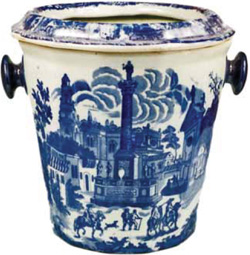
Fig. 1 New two-piece chamber pot, or slops bucket; 12 inches tall, 12 inches across handles.

Fig. 2 New 8-inch Blue Willow sugar pot. Background is factory "distressed" to off-white, slightly brown color.
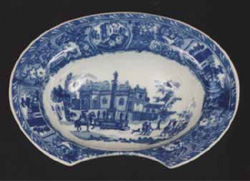
Fig. 3 New version of very rare original shape. Called either a shaving basin or barber's bowl, the crescent-shaped opening would be placed against a man's neck under his chin. The bowl held warm water.
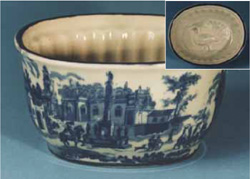
Fig. 4 New food mold, 6½ by 4-inches. No food molds known in 19th century blue transfer ware. Inset shows mold design, a turkey or peacock-like bird.

Fig. 5

Fig. 6
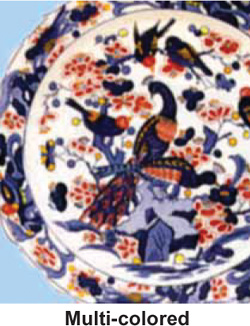
Fig. 7
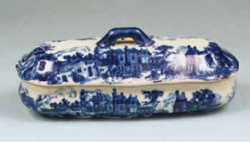
Fig. 8 New 8-inch covered box. Shape copied from 19th century toothbrush holder.

Fig. 9 Inside view of toothbrush holder in Fig. 8 This piece has the typical unglazed rims. Old rims are generally glazed.
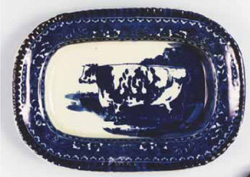
Fig. 10 New 11-inch platter, cow decoration.
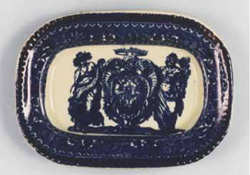
Fig. 11 New 11-inch platter, seal with Latin motto.

Fig. 12 New two-piece reamer. Fantasy shape, no old pieces in this shape exist.

Fig. 13 Rims on the majority of new lids are not glazed. Most new pieces also have very wide unglazed standing rims.

Fig. 14 Blue transfer reproductions from the 1970s to 1980s frequently have hollow handles. These are formed by slip casting. Handles on original pieces are solid. This is only a partial test–blue transfer reproductions made in China since the mid-1990s have solid handles like originals.

Fig. 15 Virtually all new blue transfer ware has a definite overall blue or blue-green tint in the glaze. Backgrounds of original blue transfer ware—Blue Willow, Flo Blue or Staffordshire—are essentially white overall without blue or blue-green tints. Shown above are the undersides of typical new and old plates.

Fig. 16 Bottom of typical reproduction showing underglaze fake mark with broad, unglazed standing rim. Area shown is the bottom of a quart-sized pitcher. The unglazed rim averages ¾-inch in width.
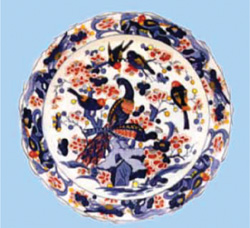
Fig. 17 New 18-inch platter, multicolored transfer.

Fig. 18 New Ironstone-style 12-inch plate, available in several single colors including blue, pink and brown transfer design.
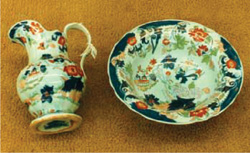
Fig. 19 New pitcher and bowl set. Multi-color transfer imitates patterns used on original 19th century Ironstone. New mark almost completely covers base of pitcher.
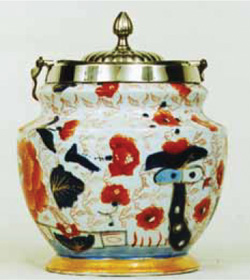
Fig. 20 New 8-inch jar. Multicolored transfer print similar to original Ironstone-type decoration.
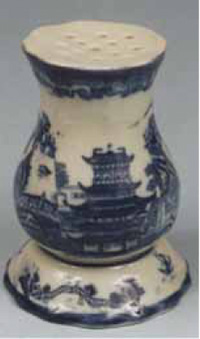
Fig. 21
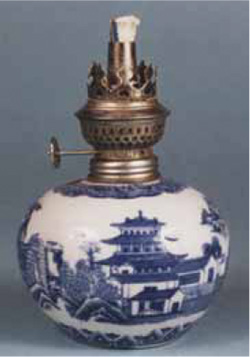
Fig. 22
Two new pieces in Blue Willow pattern: 5-inch hatpin holder; oil lamp, 4½-inch diameter. The new hatpin holder appears with many different transfer patterns. The oil lamp is a fantasy shape; no 19th century counterpart exists.
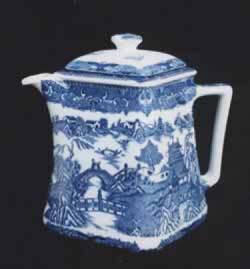
Fig. 23 New 8-inch Blue Willow teapot, marked Ringtons as in Fig. 24 on base. Fantasy shape, originals were low and oblong-shaped.
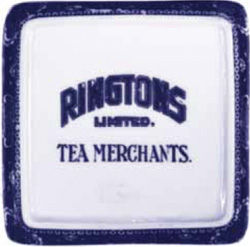
Fig. 24 New mark on teapot and jar in Figs. 23 and 25. Compare to original mark, Fig. 28.

Fig. 25 New 8-inch Blue Willow tea jar. New Ringtons mark in Fig. 24. Identical to an original shape.
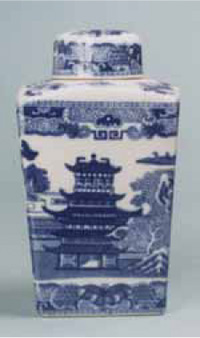
Fig. 26 New 8-inch Blue Willow tea jar is identical in shape to an original jar.
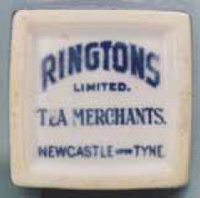
Fig. 27 New mark on base of jar in Fig. 26. This new mark is identical to an original mark used 1928 to 1955. Inside of new lid is not glazed.
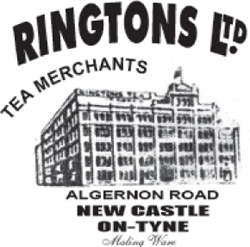
Fig. 28 So far, the original Ringtons mark that appears on old teapots has not been reproduced. Note that "Maling Ware" is included at the bottom. Maling Ware does not appear in any new Ringtons mark.
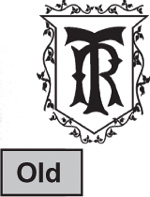
Fig. 29 Almost all original Ringtons Tea jars and tea pots have a "R" and "T" monogram under the lids.

Fig. 30 Marks on new blue transfer ware are very large. Many are 2 to 3 inches across. Many new marks completely cover the bases of reproductions. Original marks are rarely over 1-inch.

Fig. 31 Size comparison of typical authentic mark on 19th century blue transfer ware.

Fig. 32 Another typical authentic mark shown for size comparison.
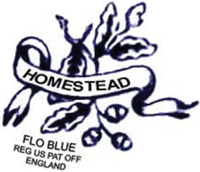
Fig. 33 New fantasy mark. No old mark includes terms used by present day antique collectors such as "Flo Blue."
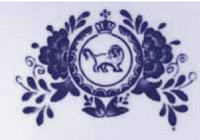
Fig. 34 Fantasy mark on ceramic reproductions from Japan. Used on pieces decorated with a wide variety of transfers including Flo Blue, Blue Willow, Ironstone, and Delft. The mark appears in dark blue, pink and brown.
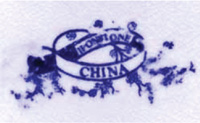
Fig. 35 Another new fantasy mark, blue underglaze. "Ironstone China" in banner. No company name, pattern name or country of origin.
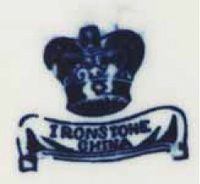
Fig. 36 New mark, blue underglaze. No factory or pattern name, no country of origin. "Ironstone" is a generic name and by itself is not a reliable indicator of age.
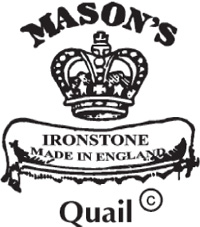
Fig. 37 Present day mark of Mason's Ironstone. Identical to 19th century mark except for modern © symbol near pattern name. "England" or "Made in England" did not appear within the old mark, only near the mark.
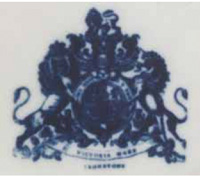
Fig. 39 Copy of British Royal Arms mark on reproductions from China. Latin motto in center shield; "Victoria Ware" in lower banner; "Ironstone" below. No country or company name. This mark has been found up to 3 inches wide. Blue underglaze.

Fig. 40 Fantasy mark, no known old counterpart. "Stone Ware" in center shield, "Victoria" in banner. Very large, over 2 inches tall. Underglaze in blue. No company name or country of origin.
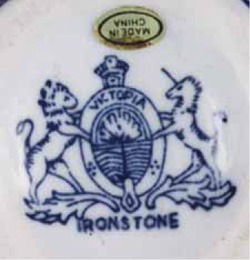
Fig. 41 Copy of British Royal Arms mark on reproductions from China. "Victoria" in shield, "Ironstone" below. Note removable paper label at top. No country or factory name.

Fig. 42 Copy of British Royal Arms mark used by Blakeney Pottery LTD, England. "Victory" in shield. Mark in use since 1968 on reproductions. Blue underglaze.
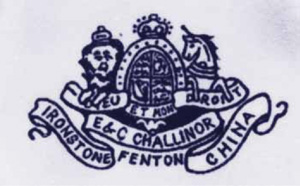
Fig. 43 One of the most confusing new marks includes the name of a 19th century manufacturer, "E. & C. Challinor." Virtually identical copy of an original 19th century mark used ca. 1862-1991. New mark is 2½ wide by 1¼ inches wide. Old marks rarely over 1½ inches wide. Most, but not all original Challinor marks also include "England." Blue underglaze.
Thank you, an interesting article! Astonishing that they copy old English blue and white while the original 18th century pieces are still on the market for affordable prices.
Birgit
Not long ago, some flow-blue pieces were getting good prices as were old blue transfer-ware meat-platters. That may be one reason why. Also, around the end of the 20th c, Mason's ironstone jugs and the like were very collectable. It seems all these are far less sought after now.
Julia
Thanks a bunch a great read.
Thanks for visiting "The BidAmount Asian Art Forum | Chinese Art"
If you sell on eBay, or have a shop feel free to post images and descriptions and links.
Check back often for discussion about the latest news in the Chinese art and antique world. Also find out about the latest Asian art auctions at Sotheby's, Christie's, Bonhams and Tajans.
Auction results for: fine porcelain, ceramics, bronze, jade, textiles and scholar's objects. As well as Japanese, Thai, Vietnamese and other Asian cultures.
Thank you,
Peter Combs
Topics and categories on The BidAmount Asian Art Forum | Chinese Art
Kangxi vases, Kangxi dishes and chargers, Kangxi ritual pieces, Kangxi scholar's objects, Qianlong famille rose, Qianlong enamels, Qianlong period paintings, Qianlong Emporer's court, Fine porcelain of the Yongzheng period. Chinese imperial art, Ming porcelain including Jiajing, Wanli, Xuande, Chenghua as well as Ming jades and bronzes.
The BidAmount Asian Art Forum | Chinese Art
A free Asian art discussion board and Asian art message board for dealers and collectors of art and antiques from China, Japan, Korea, Thailand, Cambodia, Vietnam and the rest of Asia. Linked to all of the BidAmount Asian art reference areas, with videos from plcombs Asian Art and Bidamount on YouTube. Sign up also for the weekly BidAmount newsletter and catalogs of active eBay listing of Chinese porcelain, bronze, jades, robes, and paintings.
The art of calligraphy - and for the ancient Chinese it certainly was an art - aimed to demonstrate superior control and skill using brush and ink. Calligraphy established itself as one of the major Chinese art forms during the Han dynasty (206 BCE - 220 CE), and for two millennia after, all educated men were expected to be proficient at it.
The Museum’s collections of Asian art span nearly five millennia and encompass the cultures of China, the Himalayas, India, Japan, Korea, and Southeast Asia. In 2007, the Museum launched an initiative to create dedicated galleries for the collection, beginning with a gallery for the arts of Korea ...
Chinese art is full of symbolism, in that artists typically seek to depict some aspect of a totality of which they are intuitively aware.
China Online Museum is the finest online museum of Chinese art. It features Chinese calligraphy, painting, ceramics, bronzes, carving, and other artworks.
Chinese Ceramics & Works of Art. Overview Upcoming auctions Contacts Auction results ... Christie’s sales of Chinese ceramics and works of art showcase centuries of Chinese history. Held throughout the year in London, New York, Paris and Hong Kong, they attract a wide audience of collectors and connoisseurs vying for pieces as diverse as ...
Explore Asian Art Week. Contact the Specialist Department. Chinese Paintings ... Senior Specialist, Head of Sale. [email protected]. Tel:+1 212 641 5760. Bid in-person or online for the upcoming auction:Fine Chinese Paintings on 10 September 2019 at New York. Bid in-person or online for the upcoming auction:Fine Chinese Paintings on 10 ...
Discover an abundance of must-see art from all corners of a vast continent at Christie’s NY Asian Art Week. From contemporary classical and Chinese paintings to works with exemplary provenance from the Art Institute of Chicago, our Rockefeller Paza galleries will be full of ancient treasures and contemporary masterworks in a salute to the vibrant arts of Asia.
Sold to benefit The Art Institute of Chicago’s Asian Art Acquisition Fund, the sale features 84 lots with a focus on Ming and Qing porcelains, and offers a rare insight into the taste for collecting Chinese ceramics and works of art in the Midwest from the end of the 19th century through the 1980s. Highlights include two Wanli wucai garlic-head vases, a Qianlong mark and period, blue and ...
Specialist, Chinese Paintings, Christie's London Dr Malcolm McNeill is a Specialist in Chinese Paintings at Christie’s, based in London. He previously worked as an assistant curator of the Chinese collections and the Victoria and Albert Museum in London, as a researcher at the British Museum, and as a translator and tour guide at the National Palace Museum in Taipei.
The Christie's Education 2020 Conference: The Chinese Art Market 18 Jun 2019 Christie’s Education is delighted to announce our first international academic conference in Asia which will take place in Hong Kong from 26-27 November 2020 at the Hong Kong Convention and Exhibition Centre and will run in parallel with Christie’s Hong Kong Autumn Auctions.
The summer Chinese Art sale in Hong Kong will feature works of art from several private collections, including Qing porcelains and textile from the collection of the legendary Chinese art dealer A. W. Bahr (1877–1959), fine gilt bronze Buddhist sculptures from an old Hong Kong collection, an East Asian collection of Qing dynasty wine cups and jades, and a Japanese collection of Song ceramics ...
Sotheby's Chinese Works of Art Department holds two auctions each year in London, New York, Hong Kong and Paris.
Chinese Art - View Auction details, bid, buy and collect the various artworks at Sothebys Art Auction House.
With more than 340 Chinese works of art dating from the Neolithic to the Republic periods, highlights of this sale include a selection of Qing Imperial monochromes from the collection of Arnold and Blema Steinberg, early ceramics from the Art Institute of Chicago and Chinese porcelain and works of art from the collection of Henry Arnhold.
Results: Sotheby's Asia Week achieved $52.4 million in six strong auctions, exceeding pre-sale estimates. With 76.5% of lots sold and 60.3% of lots surpassing high estimates, the Asian art sales at Sotheby's indicate continued collector interest in the finest works of art from China, India and and the Himalayas.
Today's sale of Important Chinese Art will proceed as planned with sessions at 10 AM and 2 PM EDT. Sotheby's will be monitoring the weather conditions throughout the day and will be available to coordinate alternative bidding options should conditions make it difficult for clients to attend the auction in person.
Bonhams Chinese Art department is renowned for offering the finest works of art representing the richness and breadth of China's artistic heritage, particularly Imperial porcelain, white and spinach green jades, cloisonné and Buddhist art. Specialised international auctions are held globally, including London, Hong Kong and San Francisco.
Bonhams : Chinese Works of Art We use cookies to remember choices you make on functionality and personal features to enhance your experience to our site. By continuing to use our site you consent to the use of cookies. Please refer to our privacy and cookie policies for more information.
Bonhams Fine Art Auctioneers & Valuers: auctioneers of art, pictures, collectables and motor cars. We use cookies to remember choices you make on functionality and personal features to enhance your experience to our site. By continuing to use our site you consent to the use of cookies. ... Chinese Art (US) General enquiries
Bonhams : Fine Chinese Art We use cookies to remember choices you make on functionality and personal features to enhance your experience to our site. By continuing to use our site you consent to the use of cookies. Please refer to our privacy and cookie policies for more information.
Bonhams Fine Art Auctioneers & Valuers: auctioneers of art, pictures, collectables and motor cars Bonhams : Asian Art We use cookies to remember choices you make on functionality and personal features to enhance your experience to our site.
Bonhams are international auctioneers of fine Chinese and Japanese art. We specialise in rare Imperial and Export Chinese ceramics and works of art, as well as Japanese ceramics, fine and decorative works of art from the Neolithic Period to the 20th century. View on map
Bonhams Fine Art Auctioneers & Valuers: auctioneers of art, pictures, collectables and motor cars. We use cookies to remember choices you make on functionality and personal features to enhance your experience to our site. By continuing to use our site you consent to the use of cookies. ... Asian Art Bonhams. Work. 22 Queen St.
